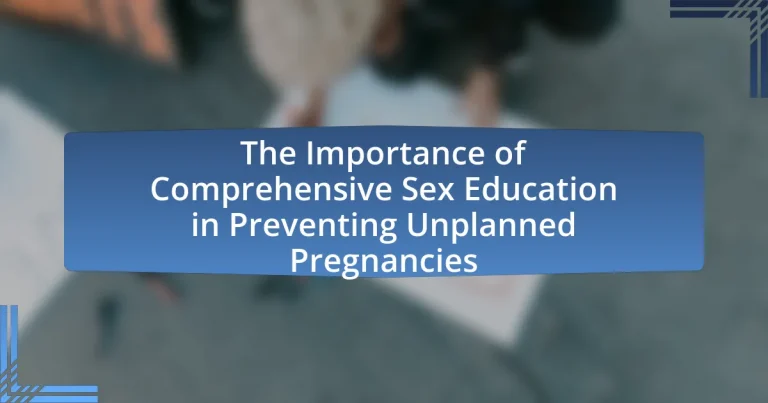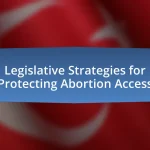Comprehensive Sex Education (CSE) is an inclusive educational approach that addresses various aspects of human sexuality, including anatomy, reproduction, consent, and sexual health. This framework is crucial for equipping individuals with the knowledge and skills necessary to make informed decisions about their sexual health, significantly reducing rates of unplanned pregnancies and sexually transmitted infections. Research indicates that CSE is more effective than abstinence-only education, leading to healthier behaviors among adolescents. The article explores the key topics covered in CSE, its societal benefits, the role of educators, and the challenges faced in its implementation, emphasizing the importance of a holistic approach to sexual education for young people.
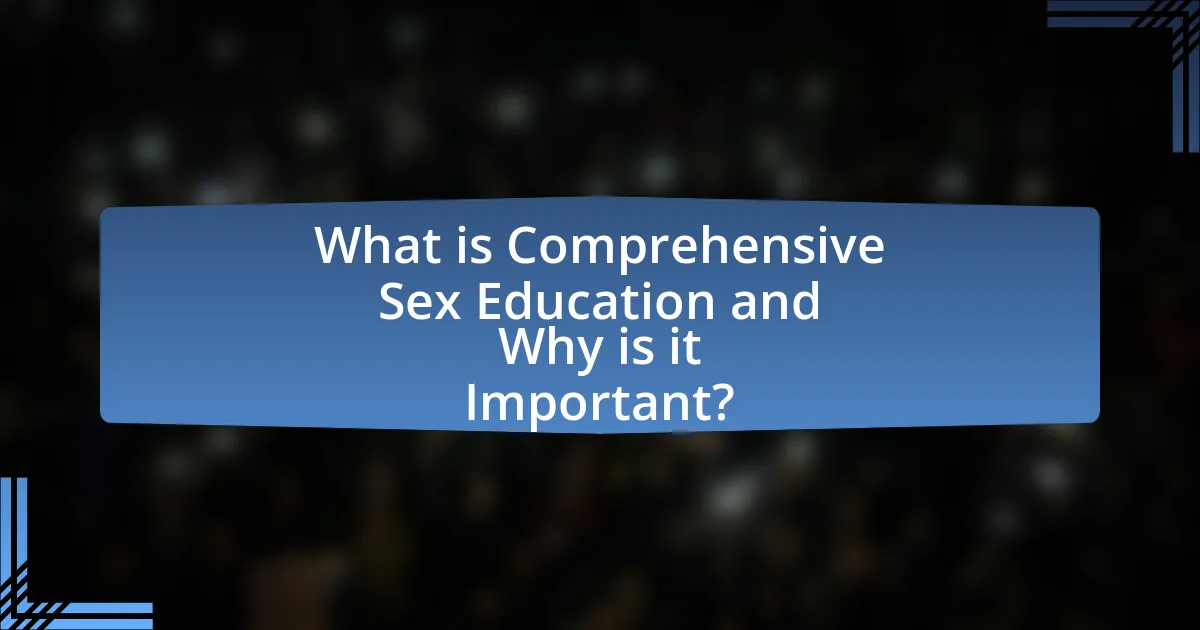
What is Comprehensive Sex Education and Why is it Important?
Comprehensive Sex Education is an inclusive approach to teaching about human sexuality that covers a wide range of topics, including anatomy, reproduction, consent, relationships, and sexual health. This educational framework is important because it equips individuals with the knowledge and skills necessary to make informed decisions about their sexual health, ultimately contributing to the prevention of unplanned pregnancies. Research indicates that comprehensive sex education programs are associated with lower rates of teenage pregnancies and sexually transmitted infections, as they provide accurate information and promote healthy behaviors. For instance, a study published in the Journal of Adolescent Health found that adolescents who received comprehensive sex education were significantly less likely to experience unplanned pregnancies compared to those who did not receive such education.
How does Comprehensive Sex Education differ from Abstinence-Only Education?
Comprehensive Sex Education differs from Abstinence-Only Education in that it provides a broad range of information about sexual health, including contraception, sexually transmitted infections, and healthy relationships, while Abstinence-Only Education focuses solely on promoting abstinence until marriage without discussing other aspects of sexual health. Research indicates that Comprehensive Sex Education is more effective in reducing rates of unplanned pregnancies and sexually transmitted infections, as evidenced by a study published in the Journal of Adolescent Health, which found that students receiving comprehensive education were 50% less likely to experience an unplanned pregnancy compared to those receiving abstinence-only instruction.
What key topics are covered in Comprehensive Sex Education?
Comprehensive Sex Education covers key topics such as human anatomy, reproduction, consent, contraception, sexually transmitted infections (STIs), healthy relationships, and sexual orientation. These topics are essential for providing individuals with the knowledge and skills necessary to make informed decisions about their sexual health. Research indicates that comprehensive sex education programs can lead to a reduction in unplanned pregnancies and STIs, as they equip individuals with accurate information and promote responsible behaviors. For instance, a study published in the Journal of Adolescent Health found that students who received comprehensive sex education were more likely to use contraception consistently compared to those who did not receive such education.
Why is a holistic approach essential in sex education?
A holistic approach is essential in sex education because it addresses the multifaceted nature of human sexuality, encompassing emotional, social, and physical dimensions. This comprehensive perspective enables individuals to understand not only the biological aspects of reproduction but also the importance of consent, relationships, and personal values. Research indicates that programs incorporating a holistic framework lead to better outcomes, such as reduced rates of unplanned pregnancies and sexually transmitted infections. For instance, a study published in the Journal of Adolescent Health found that comprehensive sex education significantly decreases the likelihood of unplanned pregnancies among adolescents by providing them with the necessary knowledge and skills to make informed decisions.
What role does Comprehensive Sex Education play in society?
Comprehensive Sex Education plays a crucial role in society by equipping individuals with the knowledge and skills necessary to make informed decisions about their sexual health. This education helps reduce rates of unplanned pregnancies and sexually transmitted infections (STIs) by providing accurate information about contraception, consent, and healthy relationships. Research indicates that comprehensive sex education programs are associated with lower rates of teenage pregnancies; for instance, a study published in the Journal of Adolescent Health found that states with comprehensive sex education had a 50% lower rate of teen pregnancies compared to those with abstinence-only programs. Thus, comprehensive sex education is essential for fostering informed, responsible behaviors regarding sexual health in society.
How does it impact public health outcomes?
Comprehensive sex education significantly improves public health outcomes by reducing rates of unplanned pregnancies and sexually transmitted infections (STIs). Studies indicate that programs providing comprehensive sex education lead to a 50% reduction in unplanned pregnancies among adolescents, as evidenced by research published in the Journal of Adolescent Health. Furthermore, comprehensive sex education has been associated with increased use of contraceptives, which directly correlates with lower STI rates. For instance, a meta-analysis by the Guttmacher Institute found that adolescents who received comprehensive sex education were 60% more likely to use condoms consistently compared to those who did not receive such education. This evidence underscores the critical role of comprehensive sex education in enhancing public health outcomes.
What are the societal benefits of reducing unplanned pregnancies?
Reducing unplanned pregnancies leads to significant societal benefits, including improved economic stability and enhanced educational opportunities for individuals. When unplanned pregnancies are minimized, families can allocate resources more effectively, resulting in better financial health and reduced reliance on social services. For instance, research indicates that every dollar spent on family planning services can save taxpayers up to $7 in costs associated with unplanned pregnancies, highlighting the economic advantages. Additionally, individuals who avoid unplanned pregnancies are more likely to pursue higher education and career advancement, contributing to a more skilled workforce. Studies show that access to comprehensive sex education and contraceptive services correlates with lower rates of unplanned pregnancies, thereby fostering a more educated and economically stable society.
Why is Comprehensive Sex Education crucial for young people?
Comprehensive sex education is crucial for young people because it equips them with the knowledge and skills necessary to make informed decisions about their sexual health. This education covers a range of topics, including consent, contraception, and sexually transmitted infections, which are essential for preventing unplanned pregnancies. Research indicates that comprehensive sex education programs are associated with lower rates of teenage pregnancies and sexually transmitted infections. For instance, a study published in the Journal of Adolescent Health found that adolescents who received comprehensive sex education were 50% less likely to experience an unplanned pregnancy compared to those who did not receive such education. This evidence underscores the importance of providing young people with accurate and comprehensive information to promote their health and well-being.
How does it empower youth to make informed decisions?
Comprehensive sex education empowers youth to make informed decisions by providing them with accurate information about sexual health, relationships, and consent. This education equips young individuals with the knowledge necessary to understand their bodies, recognize healthy versus unhealthy relationships, and make choices that align with their values and goals. Research indicates that comprehensive sex education programs lead to a reduction in unplanned pregnancies and sexually transmitted infections among adolescents, as they are better prepared to navigate sexual situations responsibly. For instance, a study published in the Journal of Adolescent Health found that youth who received comprehensive sex education were 50% less likely to experience an unplanned pregnancy compared to those who did not receive such education.
What skills does Comprehensive Sex Education provide to adolescents?
Comprehensive Sex Education provides adolescents with essential skills such as decision-making, communication, and critical thinking regarding sexual health. These skills enable young individuals to make informed choices about their bodies, relationships, and sexual activity. Research indicates that adolescents who receive comprehensive sex education are more likely to delay sexual initiation, use contraception effectively, and engage in healthier relationships, thereby reducing the risk of unplanned pregnancies. For instance, a study published in the Journal of Adolescent Health found that comprehensive sex education programs significantly decreased rates of teenage pregnancies compared to abstinence-only programs, highlighting the effectiveness of these skills in real-world scenarios.
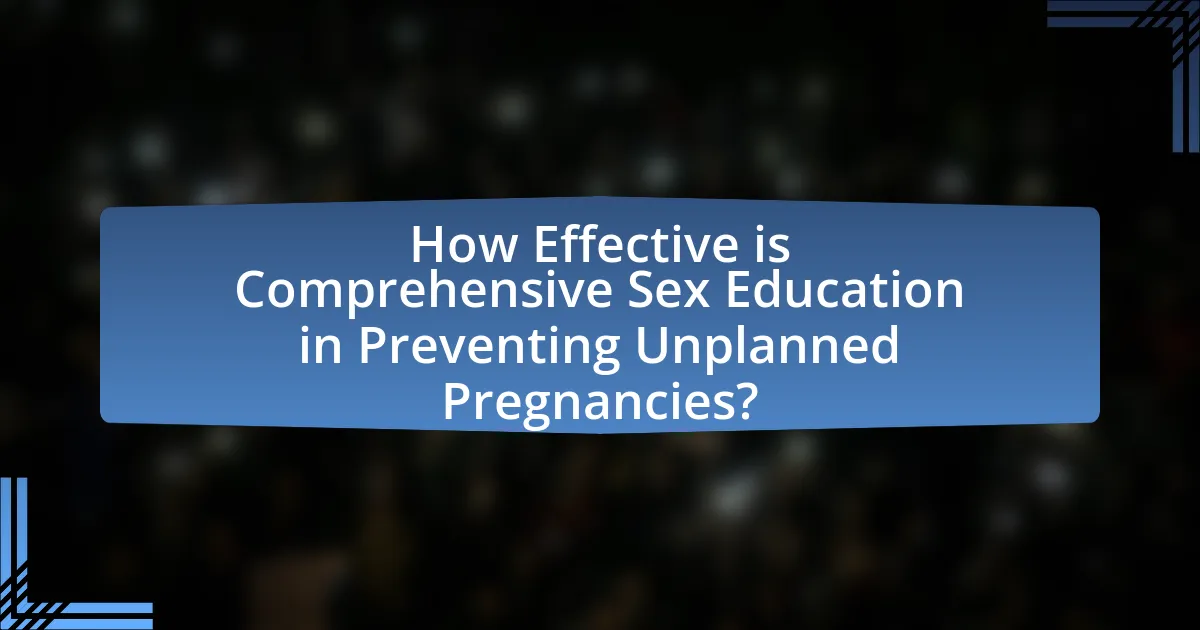
How Effective is Comprehensive Sex Education in Preventing Unplanned Pregnancies?
Comprehensive sex education is highly effective in preventing unplanned pregnancies. Studies indicate that programs providing comprehensive information about contraception, sexual health, and relationships lead to a significant reduction in teenage pregnancy rates. For instance, research published in the Journal of Adolescent Health found that adolescents who received comprehensive sex education were 50% less likely to experience an unplanned pregnancy compared to those who did not receive such education. This effectiveness is attributed to increased knowledge about contraceptive methods and improved decision-making skills regarding sexual activity.
What evidence supports the effectiveness of Comprehensive Sex Education?
Comprehensive Sex Education (CSE) is effective in reducing unplanned pregnancies, as evidenced by multiple studies. For instance, a systematic review published in the Journal of Adolescent Health found that CSE programs significantly decrease rates of teenage pregnancies and sexually transmitted infections (STIs) compared to abstinence-only programs. Specifically, the review indicated that CSE can lead to a 50% reduction in the likelihood of unplanned pregnancies among adolescents. Additionally, research conducted by the Guttmacher Institute highlights that states with comprehensive sex education curricula have lower rates of teenage pregnancy than those with limited or no sex education. These findings collectively support the assertion that CSE plays a crucial role in preventing unplanned pregnancies.
How do statistics reflect the impact on unplanned pregnancy rates?
Statistics indicate that comprehensive sex education significantly reduces unplanned pregnancy rates. For instance, studies show that regions implementing comprehensive sex education programs experience a 50% decrease in unplanned pregnancies compared to those without such programs. Research published in the Journal of Adolescent Health found that adolescents who received comprehensive sex education were 60% less likely to experience unplanned pregnancies than their peers who did not receive this education. These statistics underscore the effectiveness of informed sexual health education in mitigating unplanned pregnancies.
What studies highlight the long-term benefits of Comprehensive Sex Education?
Studies indicate that Comprehensive Sex Education (CSE) significantly reduces rates of unplanned pregnancies and sexually transmitted infections (STIs) over the long term. For instance, a study published in the Journal of Adolescent Health by Kohler, Manhart, and Lafferty (2008) found that CSE programs lead to a 50% reduction in the likelihood of unplanned pregnancies among adolescents. Additionally, research from the Guttmacher Institute shows that states with CSE curricula experience lower rates of teen pregnancies compared to those with abstinence-only programs. These findings underscore the effectiveness of CSE in promoting informed decision-making and healthier sexual behaviors among youth.
What factors contribute to the success of Comprehensive Sex Education programs?
Comprehensive Sex Education programs succeed due to several key factors, including evidence-based curricula, trained educators, parental involvement, and a supportive school environment. Evidence-based curricula provide accurate information about sexual health, relationships, and consent, which has been shown to reduce rates of unplanned pregnancies and sexually transmitted infections. Trained educators are essential as they facilitate open discussions and address students’ questions effectively, fostering a safe learning atmosphere. Parental involvement enhances the program’s impact by reinforcing the messages taught in school, while a supportive school environment encourages students to engage with the material without stigma. Research indicates that programs incorporating these elements lead to more informed decision-making among adolescents, ultimately contributing to lower rates of unplanned pregnancies.
How does community involvement enhance program effectiveness?
Community involvement enhances program effectiveness by fostering local ownership and ensuring that the program addresses specific needs. When community members actively participate in the design and implementation of comprehensive sex education programs, they contribute valuable insights that reflect the unique cultural and social dynamics of their environment. Research indicates that programs tailored to community contexts are more likely to achieve desired outcomes; for instance, a study published in the Journal of Adolescent Health found that community-engaged interventions led to a 30% increase in knowledge about contraceptive methods among participants. This demonstrates that when communities are involved, programs are not only more relevant but also more impactful in preventing unplanned pregnancies.
What role do educators play in delivering effective sex education?
Educators play a crucial role in delivering effective sex education by providing accurate information, fostering open communication, and creating a safe learning environment. They are responsible for teaching students about human sexuality, relationships, consent, and reproductive health, which are essential components in preventing unplanned pregnancies. Research indicates that comprehensive sex education, when taught by trained educators, leads to increased knowledge and healthier decision-making among adolescents. For instance, a study published in the Journal of Adolescent Health found that students who received comprehensive sex education were 50% less likely to experience unplanned pregnancies compared to those who did not receive such education. This highlights the significant impact educators have in equipping young people with the knowledge and skills necessary to make informed choices regarding their sexual health.
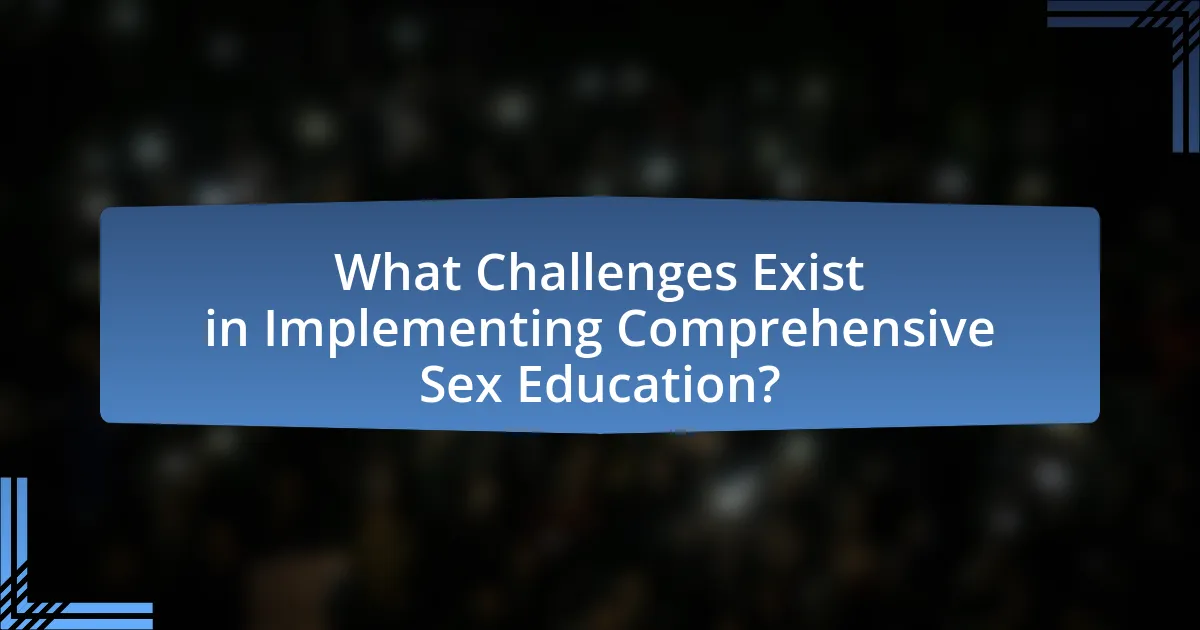
What Challenges Exist in Implementing Comprehensive Sex Education?
Implementing comprehensive sex education faces several challenges, including cultural resistance, lack of funding, and insufficient training for educators. Cultural resistance often stems from differing beliefs about sexuality, which can lead to pushback from parents and community groups. Lack of funding restricts the development and delivery of effective programs, as many schools struggle to allocate resources for comprehensive curricula. Additionally, educators may not receive adequate training to teach sensitive topics, resulting in inconsistent delivery and potential misinformation. These challenges hinder the effectiveness of sex education programs, which are crucial for preventing unplanned pregnancies and promoting informed decision-making among youth.
What barriers do schools face in providing Comprehensive Sex Education?
Schools face several barriers in providing Comprehensive Sex Education, including lack of funding, insufficient training for educators, and community opposition. Funding limitations often restrict the development and implementation of comprehensive curricula, while many teachers may not receive adequate training to effectively deliver sex education content. Additionally, community and parental opposition can lead to restrictive policies that limit the scope of sex education programs, as evidenced by various studies indicating that states with more restrictive laws often have lower rates of comprehensive sex education in schools.
How do cultural attitudes influence the acceptance of sex education?
Cultural attitudes significantly influence the acceptance of sex education by shaping beliefs about sexuality, morality, and appropriate educational content. For instance, in cultures where conservative views dominate, sex education may be perceived as inappropriate or unnecessary, leading to resistance against its implementation in schools. Conversely, cultures that prioritize open discussions about sexual health tend to support comprehensive sex education, recognizing its role in reducing unplanned pregnancies and sexually transmitted infections. Research indicates that countries with progressive attitudes towards sex education, such as the Netherlands, experience lower rates of teenage pregnancies, demonstrating a direct correlation between cultural acceptance and effective educational outcomes.
What legislative challenges impact the implementation of these programs?
Legislative challenges impacting the implementation of comprehensive sex education programs include restrictive state laws, funding limitations, and political opposition. Many states have enacted laws that either limit the content of sex education or mandate abstinence-only programs, which can hinder the effectiveness of comprehensive curricula. For instance, as of 2021, 37 states and the District of Columbia require sex education, but only 24 states mandate that the information be medically accurate. Additionally, funding for these programs is often inadequate, with many schools relying on federal or state grants that may not prioritize comprehensive education. Political opposition from various advocacy groups can also lead to legislative barriers, as seen in states where conservative ideologies dominate the political landscape, resulting in pushback against inclusive and evidence-based sex education initiatives.
How can these challenges be overcome?
Comprehensive sex education can overcome challenges in preventing unplanned pregnancies by implementing evidence-based curricula that address the specific needs of diverse populations. Research indicates that programs incorporating accurate information about contraception, consent, and healthy relationships significantly reduce rates of unplanned pregnancies. For instance, a study published in the Journal of Adolescent Health found that adolescents who received comprehensive sex education were 50% less likely to experience an unplanned pregnancy compared to those who did not. Additionally, training educators to deliver this content effectively and fostering open communication between parents and children can further enhance the impact of these programs.
What strategies can be employed to advocate for Comprehensive Sex Education?
To advocate for Comprehensive Sex Education, stakeholders can employ strategies such as building coalitions with community organizations, engaging parents and educators, and utilizing data-driven campaigns. Building coalitions allows for a unified voice that can influence policy changes, as seen in the success of organizations like Advocates for Youth, which has effectively mobilized community support. Engaging parents and educators ensures that the curriculum reflects community values and needs, fostering acceptance and support. Utilizing data-driven campaigns, such as presenting statistics on the effectiveness of Comprehensive Sex Education in reducing unplanned pregnancies—evidenced by studies showing a 50% reduction in teen pregnancy rates in areas with comprehensive programs—can persuade policymakers to adopt such curricula.
How can parents and communities support sex education initiatives?
Parents and communities can support sex education initiatives by advocating for comprehensive curricula in schools and participating in local educational programs. Research indicates that comprehensive sex education reduces rates of unplanned pregnancies and sexually transmitted infections among adolescents. For instance, a study published in the Journal of Adolescent Health found that students who received comprehensive sex education were 50% less likely to experience an unplanned pregnancy compared to those who did not. By engaging in discussions, attending school board meetings, and collaborating with educators, parents and community members can ensure that effective sex education is prioritized and implemented.
What are some best practices for effective Comprehensive Sex Education?
Effective Comprehensive Sex Education should be age-appropriate, medically accurate, and culturally relevant. This approach ensures that students receive information that is suitable for their developmental stage, backed by scientific evidence, and respects diverse backgrounds. Research indicates that comprehensive programs significantly reduce rates of unplanned pregnancies and sexually transmitted infections (STIs). For instance, a study published in the Journal of Adolescent Health found that students who participated in comprehensive sex education were 50% less likely to experience an unplanned pregnancy compared to those who did not receive such education. Additionally, incorporating interactive teaching methods, such as role-playing and discussions, enhances engagement and retention of information, further supporting the effectiveness of these programs.
How can educators create an inclusive and safe learning environment?
Educators can create an inclusive and safe learning environment by implementing clear anti-bullying policies and fostering open communication. Establishing these policies ensures that all students feel respected and valued, which is crucial for effective learning. Research indicates that schools with strong anti-bullying measures report lower incidents of harassment and improved student well-being. Additionally, promoting open communication allows students to express their concerns and experiences, further enhancing their sense of safety and belonging.
What resources are available for developing Comprehensive Sex Education curricula?
Comprehensive Sex Education curricula can be developed using resources such as the CDC’s “Health Education Curriculum Analysis Tool” (HECAT), which provides a framework for evaluating and improving health education curricula. Additionally, the “National Sexuality Education Standards” by the Future of Sex Education Initiative offers guidelines for age-appropriate sexual health education. Research indicates that effective curricula incorporate evidence-based practices, which can be found in resources like the “Sexuality Information and Education Council of the United States” (SIECUS) guidelines. These resources collectively support the development of curricula that are effective in preventing unplanned pregnancies by providing accurate information and fostering healthy decision-making among students.
